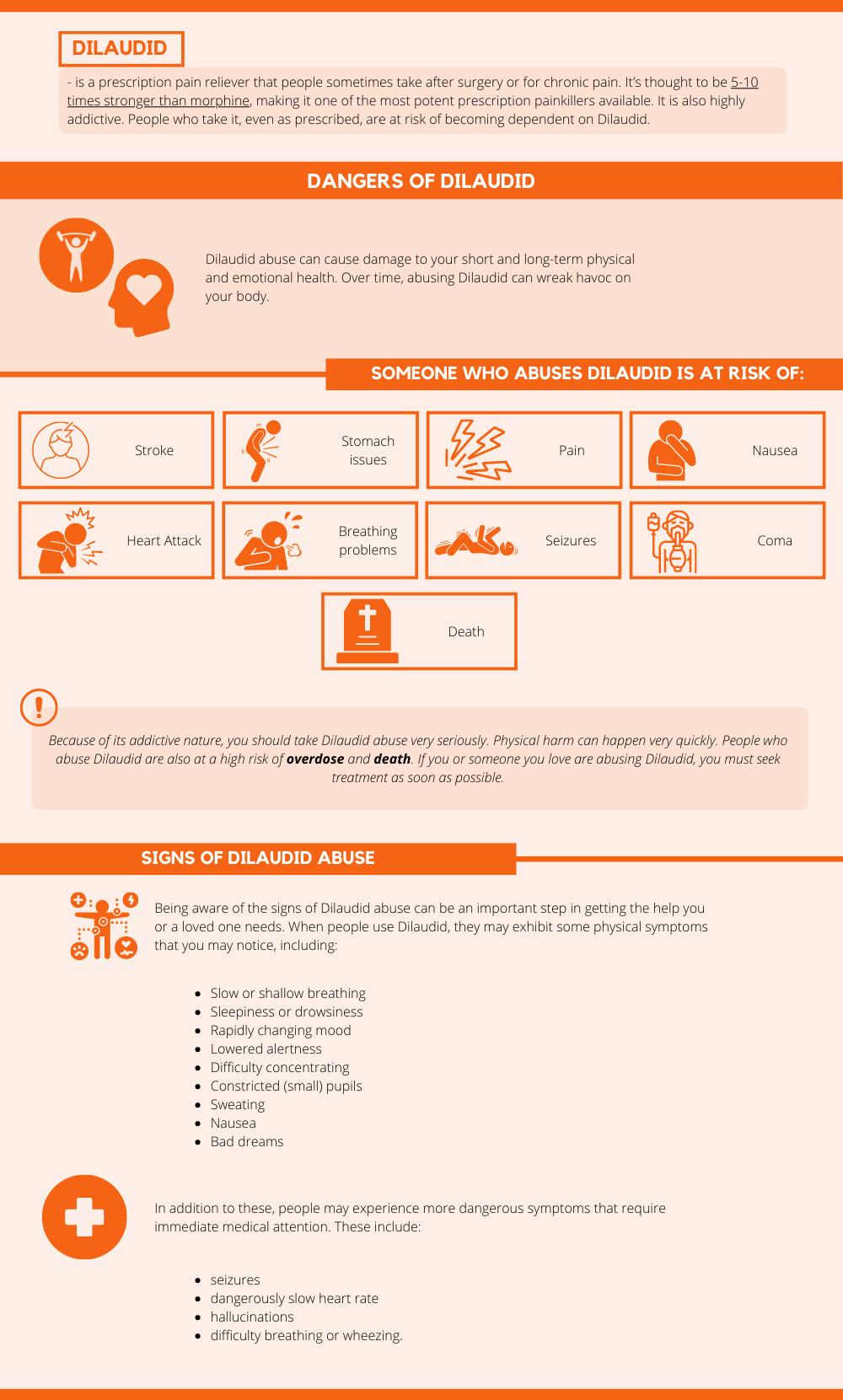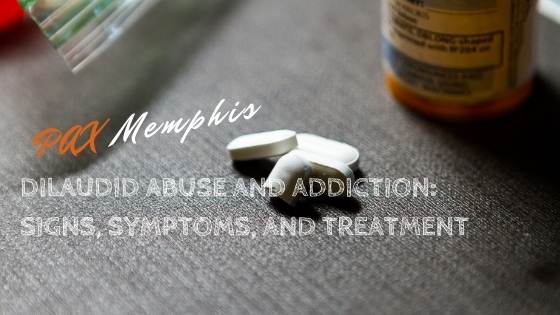Dilaudid is a prescription pain reliever that people sometimes take after surgery or for chronic pain. It’s thought to be 5-10 times stronger than morphine, making it one of the most potent prescription painkillers available.[1] It is also highly addictive. People who take it, even as prescribed, are at risk of becoming dependent on Dilaudid. Many people who start out taking it as prescribed begin to use it in higher doses to achieve a “high” feeling. As time goes on, they may start to take more than prescribed or continue to take it after their doctor recommends.
Dilaudid abuse is very serious. People can very quickly develop an addiction to it and are at high risk of dangerous consequences, including long-term harm to their health and overdose. Dilaudid abuse and addiction require immediate intervention and treatment. Learning about how to identify the signs and symptoms of Dilaudid abuse is an important first step in getting life-saving addiction treatment.

Dangers of Dilaudid
Dilaudid abuse can cause damage to your short and long-term physical and emotional health. Over time, abusing Dilaudid can wreak havoc on your body. Someone who abuses Dilaudid is at risk of:
- Stroke
- Stomach issues/pain and nausea
- Heart attack
- Breathing problems
- Seizures
- Coma
- Death
Because of its addictive nature, you should take Dilaudid abuse very seriously. Physical harm can happen very quickly. People who abuse Dilaudid are also at a high risk of overdose and death. If you or someone you love are abusing Dilaudid, you must seek treatment as soon as possible.
Signs of Dilaudid Abuse
Being aware of the signs of Dilaudid abuse can be an important step in getting the help you or a loved one needs. When people use Dilaudid, they may exhibit some physical symptoms that you may notice, including:
- Slow or shallow breathing
- Sleepiness or drowsiness
- Rapidly changing mood
- Lowered alertness
- Difficulty concentrating
- Constricted (small) pupils
- Sweating
- Nausea
- Bad dreams
In addition to these, people may experience more dangerous symptoms that require immediate medical attention. These include seizures, dangerously slow heart rate, hallucinations, and difficulty breathing or wheezing.[2]
Dilaudid abuse can also lead to other dangerous or life-threatening behaviors. Some people may move on to cheaper drugs that give the same high as Dilaudid, including heroin. Some may steal or commit other crimes to support their use of the drug. It is common for people to get into legal trouble while abusing Dilaudid. Losing jobs and relationships are other common consequences for people who abuse Dilaudid. It is a dangerous drug, and the sooner an addiction is addressed and treated, the better the outcome will be.
Signs of Dilaudid Addiction
It is important to recognize the signs of Dilaudid addiction as early as possible to avoid severe damage to the person’s physical, emotional, and social health.
Addiction involves developing tolerance. Tolerance means needing more of the drug to get the same effect. With Dilaudid, tolerance can develop in as little as one to three weeks. Even when using Dilaudid as prescribed, people may quickly lose the ability to control their use of the drug.
Some common signs of opiate addiction include:
- Using the drug despite negative consequences
- Needing more to get the same results or “high”
- Isolating self from loved ones
- Behavioral changes–sleep, mood, appetite
- Absences at school or work
- Failing to keep up with responsibilities at home
Treatment is available for people who abuse Dilaudid. Getting treatment early is the best way to give people the chance to overcome their addiction.
Treatment for Dilaudid Addiction
Dilaudid is highly addictive and many people require treatment to overcome their addiction to it. When a person attempts to cut back on the amount of Dilaudid they take or to stop taking it completely, they are likely to experience intense cravings for the drug. These cravings are often almost impossible to ignore and many people relapse and use Dilaudid again.
In addition to cravings, withdrawal from Dilaudid is often extremely uncomfortable.[3] People experience a range of symptoms, including:

- Body aches
- Insomnia
- Tremors
- Increased heart rate
- Nausea and vomiting
- Agitation
- Depression
Medical detox and addiction treatment are important to overcome addiction to Dilaudid. During medical detox, people are monitored and treated for uncomfortable withdrawal symptoms. They are also given the chance to detox completely without giving in to their intense cravings for the drug. After a period of safe detox, people move on to treatment that can give them the skills to overcome addiction and live their life without using substances.
Learn More About Treatment for Dilaudid Addiction at PAX Memphis Recovery Center
If you or someone you love struggle with Dilaudid abuse or addiction, you do not have to manage it alone. Supportive detox and addiction treatment are available through PAX Memphis Recovery Center. Our staff works with people to overcome addiction and wants to help you live the healthy, self-directed life you deserve. Call to speak with one of our admissions counselors today.
References:
Medically Reviewed: September 25, 2019

All of the information on this page has been reviewed and verified by a certified addiction professional.










